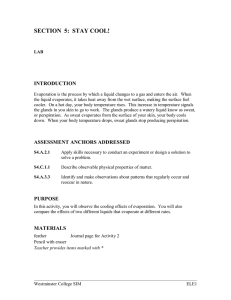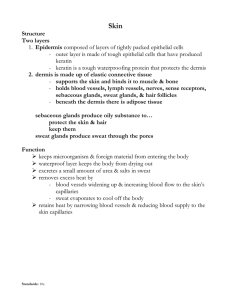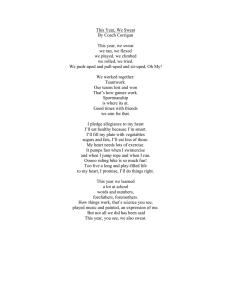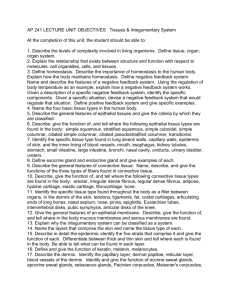Sweat glands El Bagre-EPF
advertisement
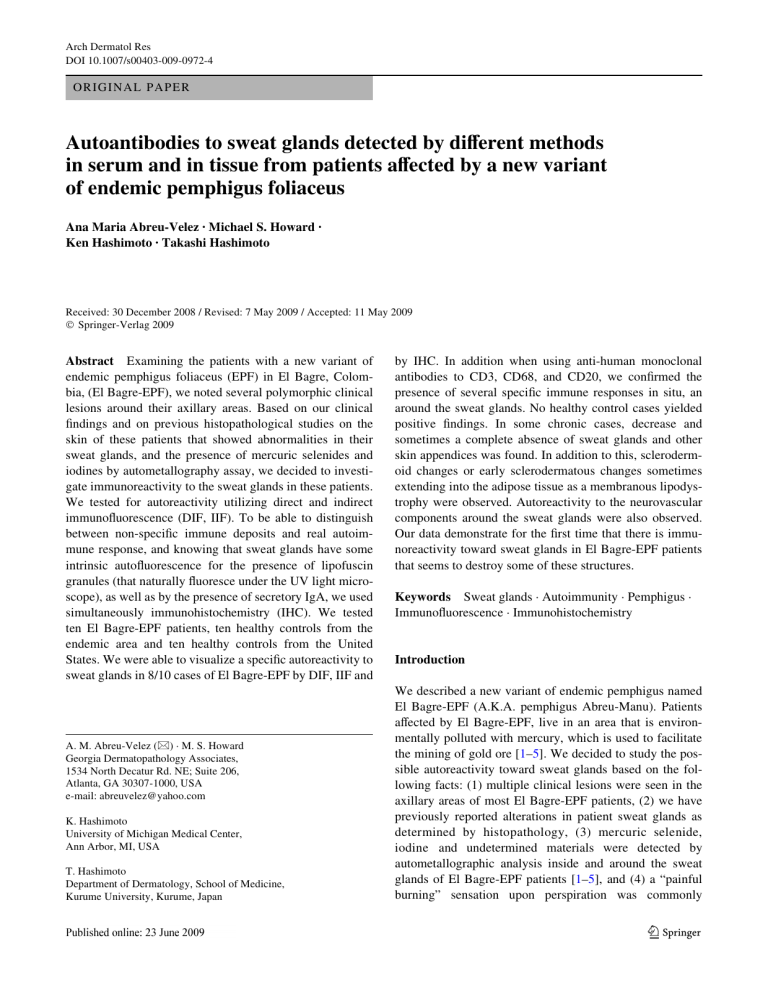
Arch Dermatol Res DOI 10.1007/s00403-009-0972-4 ORIGINAL PAPER Autoantibodies to sweat glands detected by diVerent methods in serum and in tissue from patients aVected by a new variant of endemic pemphigus foliaceus Ana Maria Abreu-Velez · Michael S. Howard · Ken Hashimoto · Takashi Hashimoto Received: 30 December 2008 / Revised: 7 May 2009 / Accepted: 11 May 2009 © Springer-Verlag 2009 Abstract Examining the patients with a new variant of endemic pemphigus foliaceus (EPF) in El Bagre, Colombia, (El Bagre-EPF), we noted several polymorphic clinical lesions around their axillary areas. Based on our clinical Wndings and on previous histopathological studies on the skin of these patients that showed abnormalities in their sweat glands, and the presence of mercuric selenides and iodines by autometallography assay, we decided to investigate immunoreactivity to the sweat glands in these patients. We tested for autoreactivity utilizing direct and indirect immunoXuorescence (DIF, IIF). To be able to distinguish between non-speciWc immune deposits and real autoimmune response, and knowing that sweat glands have some intrinsic autoXuorescence for the presence of lipofuscin granules (that naturally Xuoresce under the UV light microscope), as well as by the presence of secretory IgA, we used simultaneously immunohistochemistry (IHC). We tested ten El Bagre-EPF patients, ten healthy controls from the endemic area and ten healthy controls from the United States. We were able to visualize a speciWc autoreactivity to sweat glands in 8/10 cases of El Bagre-EPF by DIF, IIF and A. M. Abreu-Velez (&) · M. S. Howard Georgia Dermatopathology Associates, 1534 North Decatur Rd. NE; Suite 206, Atlanta, GA 30307-1000, USA e-mail: abreuvelez@yahoo.com K. Hashimoto University of Michigan Medical Center, Ann Arbor, MI, USA T. Hashimoto Department of Dermatology, School of Medicine, Kurume University, Kurume, Japan by IHC. In addition when using anti-human monoclonal antibodies to CD3, CD68, and CD20, we conWrmed the presence of several speciWc immune responses in situ, an around the sweat glands. No healthy control cases yielded positive Wndings. In some chronic cases, decrease and sometimes a complete absence of sweat glands and other skin appendices was found. In addition to this, sclerodermoid changes or early sclerodermatous changes sometimes extending into the adipose tissue as a membranous lipodystrophy were observed. Autoreactivity to the neurovascular components around the sweat glands were also observed. Our data demonstrate for the Wrst time that there is immunoreactivity toward sweat glands in El Bagre-EPF patients that seems to destroy some of these structures. Keywords Sweat glands · Autoimmunity · Pemphigus · ImmunoXuorescence · Immunohistochemistry Introduction We described a new variant of endemic pemphigus named El Bagre-EPF (A.K.A. pemphigus Abreu-Manu). Patients aVected by El Bagre-EPF, live in an area that is environmentally polluted with mercury, which is used to facilitate the mining of gold ore [1–5]. We decided to study the possible autoreactivity toward sweat glands based on the following facts: (1) multiple clinical lesions were seen in the axillary areas of most El Bagre-EPF patients, (2) we have previously reported alterations in patient sweat glands as determined by histopathology, (3) mercuric selenide, iodine and undetermined materials were detected by autometallographic analysis inside and around the sweat glands of El Bagre-EPF patients [1–5], and (4) a “painful burning” sensation upon perspiration was commonly 123 Arch Dermatol Res described in patients aVected by El Bagre-EPF. Therefore, we focused on possible autoimmune reactivity within the sweat glands by using direct and indirect immunoXuorescence (DIF, IIF), and by immunohistochemistry (IHC) (where neither lipofuscin nor secretory IgA autoXuorescence is detected using this method) to diVerentiate between background and speciWc autoimmune responses to sweat glands in these patients. IIF was performed also to determine if the serum of the patients recognize the sweet gland components. This is an important step to diVerentiate between immune deposits and autoimmunity, since immune deposits can result from non-speciWc adherence of antibodies to these glands. Materials and methods Subjects of study A case–control study was performed. We studied ten patients who fulWlled the diagnosis of El Bagre-EPF [1–5]. The El Bagre-EPF diagnosis was based on clinical, epidemiological, histopathological and immunological criteria previously reported by us and others [1–5]. Skin biopsies were taken from the patients and examined histopathologically [1–5]. H&E revealed that around one-fourth of the patients showed and several alterations on the sweat glands. The typical acantholysis was detected in new and active lesions. Positive intercellular staining on the cell junctions between keratinocytes (ICS) as well as BMZ was shown by DIF and IIF [1–5, 8]. In addition, sera used to test immunoreactivity to sweat glands in this study were properly characterized by immunoprecipitation using the Concanavalin-A aYnity puriWed bovine tryptic fragment (45 kDa ectodomain of the mature form of Dsg1) as described by us previously [1–5]. Sera from all patients and controls from the endemic area were also tested by immunoblotting for reactivity against skin extracts showing positivity to desmoglein 1, desmoplakin, periplakin and other antigens. The samples were also tested positive as determined by an enzyme-linked immunosorbent assay (ELISA) that we developed and reported elsewhere [5]. For all of the above determinations, sera from a sporadic pemphigus foliaceus (PF) and a paraneoplastic pemphigus patient (PNP) were used as positive controls. We also tested ten healthy control sera from the endemic area and ten normal controls from the United States as negative controls. We obtained informed consent from all patients, and this study was performed. All samples were tested anonymously to comply with Institutional Review Board (IRB) requirements. The samples were imported to the USA in compliance with the Center for Disease Control (CDC) regulations in Atlanta. 123 DIF and IIF Following local anesthesia without epinephrine, skin biopsies were taken from the dominantly aVected areas of the axillae and kept in Michel’s medium for DIF. In addition, the sera from the patients and controls were obtained. For IIF, the sera were tested using both normal human skin obtained from esthetic reduction procedures and by monkey esophagus (Oregon Primate Center, Portland, Oregon, USA) as substrates. For IIF, we used the serum at 1:25 and 1:40 dilutions in phosphate buVered saline (PBS). For DIF, in brief, 4 m thick skin cryosections partially Wxed with paraformaldehyde and then rinsed in PBS and incubated in a solubilization buVer (PBS, 0.5% Triton X-100, pH 6.8) and rinsed. After incubation with the sera, the slides were rinsed and blocked with PBS-0.01% Tween and 0.5% bovine serum albumin (BSA), and further incubated with the secondary antibodies. For DIF, we used FITC-conjugated rabbit antisera to human IgG, IgA, IgM, C3, C1q, Wbrinogen and albumin. FITC-conjugated rabbit antihuman IgG ( chain) (1:20 to 1:40), IgA ( chains) (1:20 to 1:40) and IgM ( chain) (1:20 to 1:40) were used. For the anti-human Wbrinogen and anti-albumin FITCI conjugate antibodies, we used 1:40 dilutions. All of these antisera were purchased from Dako (Carpenteria, California, USA). Goat anti-human IgE antiserum conjugated with FITC from Vector Laboratories (Bridgeport, NJ, USA) and anti-human IgD FITC-conjugated antibodies (Southern Biotechnology, Birmingham, Alabama) were also used. The slides were counterstained with DAPI (Pierce, Rockford, Illinois, USA), washed, cover slipped and dried overnight at 4°C. Other antibodies used in addition to those outlined above included mouse anti-collagen IV monoclonal antibody (CIV), Clone CIV (Zymed®; Invitrogen, Carlsbad, California, USA) and its secondary donkey anti-mouse IgG (H + L) antiserum conjugated with Alexa Fluor 555 (Invitrogen, USA). These experiments were performing in order to determine co-localization of the autoantibodies from the patients. In addition to this, to diVerentiate between speciWc immune deposits on sweet glands we performed IIF with titration of those found positive. This assay was performing to be able to distinguish between non speciWc immune deposits and autoimmunity, since immune deposits can result from non-speciWc adherence of antibody. Finally, the sections were examined with a Nikon Eclipse 50i microscope (Japan), using a Xenon arc light (XBO 75W) as the light source and a PL Apo £ 40/0.80 dry objective. The slides were then examined using FITC alone, as well with a Nikon Wlter, i.e., DAPI/ FITC/TEXAS RED EX 395–410/490–505/560–585 nm, EM 450–490/515–545/ 600–652 nm. To distinguish between genuine immunoreactivity and autoXuorescence of tissue, ten skin biopsies from patients Arch Dermatol Res and controls were also tested utilizing a Dako immunoperoxidase staining kit for IHC by using goat anti-human total IgG/A/M/C3-horse-radish peroxidase (HRP) (Zymed®; Invitrogen), following the manufacturer’s instructions. IHC We performed IHC to diVerentiate between speciWc autoreactivity and non-speciWc intrinsic autoXuorescence produced by the physiological presence of lipofuscin granules in the sweat glands, as well as the natural secretion of IgA. The rationale for these experiments was that these two molecules (lipofuscin and IgA) would not be detected by using anti-human IgG conjugated with HRP-labeled secondary antibodies. We also performed special stains using several monoclonal antibodies to try to determine the nature of the inXammatory cells located around the sweat glands. For this purpose, we used IHC staining using mouse antihuman CD3 monoclonal antibody or mouse anti-human CD20 monoclonal antibody. In addition, to verify the nature of the sweat glands, we used monoclonal mouse anti-human carcinoembryonic antigen (CEA) isotype IgG1 kappa and mouse anti-human monoclonal CD 68 isotype IgG3 kappa (ready to use solution) also from Dako. For all these IHC tests, we used dual endogenous peroxidase blockage, according to the Dako package insert, but with the addition of Envision dual link (to assist in chromogen attachment). Furthermore, we applied 3,3-diaminobenzidine and counterstained with hematoxylin. The samples were run in a Dako Autostainer Universal Staining System. Immunoblotting (IB) procedure The sera were evaluated by IB using dodecyl sulfate polyacrylamide gel electrophoresis (SDS-PAGE) and human skin samples, which were extracted in 62.5 mM Tris–HCl buVer (pH 6.0). In brief, SDS extractions were performed and rinsed with ice-cold TBS (10 mM Tris–HCl, 150 mM NaCl, pH 8.0). The skin was lysed in 1% SDS in TBS with 2 mM 1 PMSF. An equal volume from each sample was centrifuged at 4°C, and after the addition of 1% SDS in TBS, the sample was mixed, boiled and vortexed. Protein concentration was determined using a Bio-Rad DC Protein Assay kit (Bio-Rad, Hercules, CA, USA), and protein content of homogenates was adjusted to equal concentrations. Equal amounts of protein were resolved using NuPage® Novex® Bis–Tris Midi Gel system (Invitrogen, Carlsbad, California) for large protein transfers; we loaded samples onto a 4–12% Bis–Tris gel and a 3–8% Tris–Acetate gel and then transferred with the iBlot™ dry blotting device and an Invitrogen XCell II™ Blot Module (Invitrogen, USA). Molecular weight standards were used in each gel (Invitrogen). We used as controls anti-Dsg1 antibody from Progen Heidelberg (1:50 dilution) and anti-desmoplakin multi-epitope antibody from the same company at 1:100 dilution. Western lightning chemiluminescence (Perkin Elmer Life Sciences, Inc., USA) was used and exposed to X-ray Wlm (Kodak, Rochester, New York). The membranes were washed twice for 10 min with PBS-Tween-20, and the Wrst antibody (serum of either patient or control) was incubated and diluted at 1:75 dilutions in 1% BSA/PBS-Tween20 and incubated for 2 h. We then washed the membranes several times with PBS-Tween-20, and then the HRPlabeled secondary antibodies, diluted in 1% BSA/PBSTween-20, were incubated with the membranes for two hours. Finally, we washed the membranes several times with PBS-Tween-20, mixed equal volumes of the enhanced luminol reagent and the oxidizing reagent, and incubated the membranes for about 1–4 min while shaking. When the proteins were visualized, the excess chemiluminescence reagent was drained, and we placed the membrane within a plastic protector. Results Figure 1 shows several of the most representative clinical Wndings around the axillae in patients aVected by El Bagre EPF. Figure 1a–e shows small excoriations, Wne scaling, hyperpigmented macules and plaques within the axillae. The clinical lesions in the axillae followed patterns similar to the lesions seen throughout the rest of the patient body, and they seemed to vary according to the clinical severity of each patient. Figure 1 shows some representative H&E stains displaying the presence of peri-inXammatory inWltrate around some sweat glands, mostly due to lymphohistocytes (Fig. 1f, g). By DIF, 8/10 El Bagre-EPF skin samples displayed positive immunoreactivity within the sweat glands at the level of the eccrine coil, the eccrine duct, the acrosyringium and/ or the secretory epidermal segment. To our surprise, by IIF, the main responses were to Wbrinogen (8/10), with about of 1:80 median titers, IgG (8/10), 1:120 median titers, albumin (6/8), 1:80 median titers, C3, (6/8), 1:40 median titers, C1q (6/8), 1:80 median titers, and IgM (6/10), 1:80 median titers, all of which displayed moderately to brightly positive speciWc Xuorescence. By IHC, positive autoreactivity showed similar results as performed by DIF or IIF, however, we also observed autoreactivity to the coiled portion of the sweat glands from (2/10) El Bagre EPF using antihuman IgE. None of the controls were positive by either IIF or DIF. Figures 1 and 2 showed some of the most representative immunological Wndings in the sweat glands. In addition, of the biopsies studied by IHC using anti-human CD3, anti-CEA, anti-CD20 and anti-CD68 antibodies, all of them showed strong positivity around the sweat glands (CD3, 123 Arch Dermatol Res Fig. 1 a–e Extended series of broad clinical Wndings on the axillae of Wve diVerent El BagreEPF patients, including hyperpigmentation, blisters, plaques, and esfacelations on erythematous base. f H&E staining demonstrating a squamatized acrosyringium of sweat glands with peri inXammatory inWltrate of mainly lymphohistocytes (£20). g A coiled glandular part of the sweat glands with peri inXammatory inWltrate at higher magniWcation (£40). h DIF of El Bagre-EPF axillae showed positive reactivity to the sweat glands when using FITC-conjugated anti-human IgG antibodies. The positive staining around the sweat glands is yellowishgreen (yellow arrows). Note that the nuclei were counterstained with TOPRO-3® (red dots). i DIF of another El Bagre EPF-patient with positive red staining (yellow arrows), as their anti-human IgG was conjugated to rhodamine CD20 and CD68), or inside the sweat glands (CAE). This conWrmed that sweat glands were suVering a speciWc immunological attack. Figure 2d shows an H&E staining displaying the presence of peri-inXammatory inWltrate around all the sweat glands with a predominance of lymphohistocytes. In Fig. 2c, g, i and j, we were able to observe that, in patients suVering for more than 6 months from El Bagre EPF (chronic cases), the immunoreactivity to the glands decreased due to the reduction or complete destruction of these glands in addition to other deep appendices. This is shown for the concomitant sclerodermoid and sclerodermatous alterations seen in the deep dermis by H&E staining (Fig. 2e, f). In Fig. 3, we show some examples of the diversity of IIF staining on monkey esophagus seen in patients aVected by EPF in El Bagre in order to illustrate the diVerences between the IIF staining of this El Bagre EPF variant and other pemphigus. Figure 3a–d displays the autoreactivity seen in classical ICS of pemphigus, but, as seen in Senear-Usher syndrome, we also see the presence of lupus band-like staining at the BMZ. We also show some intracytoplasmic and perinuclear staining whose speciWc antigens still need to be uncovered. In Fig. 3c and d, we show autoreactivity to some superWcial skin vessels located under the BMZ, as well as some reactivity to part of the 123 muscularis of the mucosa of the monkey esophagus samples. These results illustrate the great diversity of autoreactivity seen in aVected individuals by this unique disease. Finally, Fig. 3 shows representative IB results of several El Bagre EPF cases and controls, illustrating strong reactivity to plakins and many other unidentiWed antigens. Table 1 Summarize the most common patterns of axillary lesions and immunopathological Wndings in the case El Bagre EPF cases versus the controls. Discussion We were able to demonstrate that patients aVected by Bagre-EPF have very unique immunological and clinical manifestations in comparison with other described forms of pemphigus. In this study, we determined that several patients aVected by El Bagre-EPF have axillae lesions, and a wide immune response is seen against sweat glands as determined by DIF, IIF and IHC. These data, together with our previous description of the presence of mercuric selenide and sulWdes within their sweat glands, led us to investigate whether the autoreactivity we Wnd in these studies may be part of this complex disease. We also found that, in Arch Dermatol Res Fig. 2 a and b IIF shows a group of positive reactivity to sweat glands when using anti-human-Wbrinogen FITC-conjugated antibodies (£40). Note the increase of Xuorescence around each intraglandular coiled duct, as well as in the coiled glandular globule glands (green-Xuorescence staining) (white arrow). In this case the nuclei were counterstained with TOPRO-3® (red dots). b We repeated the experiments using unconjugated rabbit anti-human Wbrinogen antibodies, and as a secondary we used rabbit anti-human Alexa 555 (both from Invitrogen). In this case, b shows a strong positive staining with Wbrinogen (red staining) (yellow arrow). c, d, j, and i We performed IHC studies, to avoid autoXuorescence of the sweat glands and to conWrm a speciWc immune response to these glands. For this reason, we decided to use a non-Xuorescent method to probe real reactivity versus non-speciWc reactivity using HRP. In Fig. 2c, we were able to demonstrate a positive brownish staining in the sweat glands using CEA (red arrow). In g, we stained with anti-CD3 (dark stain) (red arrow), and in i with anti- CD68 (dark staining) (red arrow). Finally, in j, IHC was performed on a paraYn-Wxed skin sample from the axillae of one El Bagre EPF patient. We used mouse anti-human CD20 monoclonal antibody following the manufacturer’s instruction. We were able to visualize CD20 positive cells around the sweat glands of this patient (£40), indirectly showing a speciWc immune response (yellow arrow) (brownish staining). h IIF staining utilizing mouse-anti-human IgA-conjugated with FITC (white arrow) (a yellowish staining) can also be due to a non-speciWc reaction due to the visualization of both lipofuscin granules and secretory IgA (blue arrow). k A schematic representation of each gland, which consists of a secretory component and an excretory duct. The secretory component is located immediately below the dermis in the subcutaneous tissue and is coiled upon itself. The secretory portion of the gland changes into a duct that proceeds toward the surface. The duct follows a spiral course through the dermis (reproduced with permission of the Skin Care Forum) chronic cases, several skin appendices, including the sweat glands, were lost in patients aVected by El Bagre EPF as visualized by H&E. In conjunction with this, sclerodermoid changes, or early sclerodermatous changes, sometimes extended into the adipose tissue as a membranous lipodystrophy. Our data prompt us to believe that this immunoreactivity toward sweat glands in El Bagre EPF patients may destroy several of these structures in several chronic cases. In addition to the reactivity to the sweat glands, we have found autoreactivity to neuro-vascular 123 Arch Dermatol Res plexus that feed the sweat glands, the sebaceous glands and other structures on the skin. (Abreu et al., manuscript in preparation). Based on these recent discoveries we cannot say yet what is the primary phenomenon (the reactivity to the sweat glands and/or to the neurovascular package) that feed this and other skin appendices. We found the dilemma of determining what was Wrst—the chicken or the egg? In regards to whether the eccrine or apoeccrine glands showed autoreactivity in our studies, with our current Wndings, we can only indirectly deduce that eccrine glands are aVected, based on their location and microscopical features [7, 10, 12, 18]. However, further studies using skin from 123 genital, peri-oral, or peri-areolar areas that are enriched with apoeccrine glands need to be performed. Traditionally, the most well-known important physiological function of eccrine glands is sweat production and cooling; however, given the physiological role and extensive and complex presence of multiple molecules, the role of these glands may be more complex. Some studies have shown that these glands could play a role in metabolism, hormone balance, adsorption, and possibly immune regulation. With this study we demonstrated autoantibodies to several components of the sweat glands. The IIF titers indicate that this phenomenon is not the result from non-speciWc adherence Arch Dermatol Res 䉳 Fig. 3 a and b IIF using monkey esophagus (Primate Center Portland, Oregon) as an antigen source for testing one of the El Bagre EPF serum samples using FITC-conjugated anti-human IgM antibodies. a Some perinuclear and intracytoplasmic staining inside the keratinocytes is seen (red arrows) (£20). b Similar to a but with DAPI as a nuclear counterstain (blue stain) (white arrows), which shows more clearly the intracellular staining (red arrows). In this case we used anti-collagen IV (CIV) monoclonal antibody and Alexa 555 as a secondary antibody (red staining). There CIV positive staining at the BMZ and a little is also present among some keratinocytes (yellow arrows). c we show autoreactivity to some superWcial and deep skin vessels located under the BMZ using anti-human Wbrinogen-FITC conjugated antibody (green stain) (blue arrows). The red-orange dots staining shows colocalization of the patient’s antibodies with an antibody to CIV around those vessels. The nuclei were counterstained with Dapi (blue stain) (white arrow) d IIF of monkey esophagus using an El Bagre-EPF patient serum sample with FITC-conjugated anti-human Wbrinogen antibody at higher ampliWcation (£100). Staining shows a positive lupus-band like staining at the BMZ (greenish staining) (fuchsia arrows). The red arrows point to a high positivity on the muscles of the mucosa using the same antibody (greenish staining). The blue arrow shows a very positive blood vessel below the BMZ (greenish staining). The nuclei were counterstained with DAPI (blue stain) (white arrow). Positive reactivity occurred with collagen IV (CIV) antibody in clumps around the BMZ (green arrow) (reddish staining) £40. e IB performed using ECL. Lane 1 is Dsg1 control (Progen, Heidelberg); lane 2 is serum from a sporadic PF patient with a positive band of 160 kDa (Dsg1); lane 3 is desmoplakin antibody from Progen (the main band is 250 kDa, but smaller possible degradation products as the result of the skin antigen preparation are seen); lane 4 shows the autoreactivity from a PNP serum showing positivity to envoplakin, periplakin, and Dsg1 with other bands; lanes 5, 6, 7, 9 and 10 are several sera from El Bagre EPF patients recognizing several plakins, desmoglein molecules and some others of unknown identity. Note that serum 10 shows some variability in the immune response. Lane 8 is a normal human serum (NHS) control, which is negative. The molecular weight standards are shown in the left of antibodies, indeed the presence of CD3, CD20 and CD68 shows an ongoing speciWc antigen presentation and selective immune response. In our studies, we addressed the intrinsic Xuorescence of the lipofuscin granules and secretory IgA by utilizing IHC to determine whether the reactivity is truly sweat gland immunoreactivity or the background autoXuorescence of sweat glands. Our results conWrmed a speciWc immunological response. For interpretation of our studies using IIF and DIF, we also took into consideration previously documented capability of some sweat glands to directly absorb selected dyes such as Bodipy FL C5. We avoided using this Xuorophore for our experiments [15, 23]. Previous reports on the autoXuorescence of sweat glands documented diVusion of Bodipy FL C5 into the sweat glands after 4–5 h and in the fat cells surrounding the sweat glands [15, 23]. In light of our Wndings, it is important to take into consideration that not only El Bagre EPF patients but also three patients with PNP showed autoreactivity to adnexal structures, including the sweat glands [6]. The authors have suggested that desmoplakins can be more strongly expressed in adnexa, including the sweat glands, than in the epidermis, facilitating visualization of antibody deposits [6]. El BagreEPF patients have several autoantibodies shared with patients suVering from PNP, as shown in this study and as previously reported by us and others [2–5]. Other studies have shown that patients were aVected by cicatricial pemphigoid (CP) and linear deposits of IgG, C3 and Wbrinogen in the base membranes of sweat glands ductus [9, 13, 21, 22]. Several pathological alterations have been documented in sweat glands, including electrolyte reabsorption, as shown in eccrine pseudochromohidrosis, where blue sweat presents in copper workers [14]. Other toxicological and metabolic alterations have been documented for these glands, including their role in patients with generalized argyria, with low ceruloplasmin and copper levels in the serum during a trial of penicillamine treatment [14]. The sweat glands also play an important role in ion exchange processes, including methylcholine-induced sweat secretion dependent on extracellular and/or the intracellular calcium concentrations [20]. Metals, metalloids and hormones Table 1 Summarize the most common patterns of axillary lesions and immunopathological Wndings in the case El Bagre EPF cases versus the controls Immunopathological Wndings El Bagre-EPF Controls from endemic an non-endemic area Positive response by IHC using CD3, CD68, and CD20, 7/10 (70%) None DIF of the sweat glands acrosyringium using IgG, albumin, Wbrinogen or C3 FITC conjugated antibodies 8/10 (100%) Albumin (+/¡), Wbrinogen (+/¡) in 1/10 controls from the endemic area, and negative in 10/10 controls from the non endemic area DIF positive at the coiled portion using IgG, albumin, Wbrinogen or C3 FITC conjugated antibodies 5/5 (100%) Negative IIF positive at the coiled portion using IgG, albumin, Wbrinogen or C3 FITC conjugated antibodies 8/10 (80%) None Necrosis of sweat glands by H & E 3/10 (30%) None Peri-inXammatory inWltrate around all the sweat glands with a predominance of lymphohistocytes by H & E 8/10 (80%) None 123 Arch Dermatol Res can interact with and compete in an allosteric manner with Ca++. Of importance to our Wndings is the fact that several other autoimmune skin diseases have been shown to have autoreactivity to sweat glands, including individuals with systemic lupus erythematosus, Sjögren’s syndrome, systemic sclerosis/morphea, diabetes, active acute systemic multiple sclerosis, and sudden onset juvenile idiopathic arthritis [16, 17]. Finally, as an associated or completely coincidental Wnding, the presence of eccrine syringoWbroadenomatosis in two patients with bullous pemphigoid and acantholysis within the sweat glands in Grover’s syndrome have been described [11, 19]. Taken together, these compiled Wndings lead to questions regarding complex role of sweat glands in El Bagre-EPF. Acknowledgments Georgia Dermatopathology Associates (MSH), Atlanta, GA, USA. The El Bagre-EPF samples were collected from previous grants from the Embassy of Japan in Colombia, DSSA, U. de A. and Mineros de Antioquia SA, (AMAV), Medellin, Colombia, South America. ConXict of interest statement None. References 1. Abréu-Vélez AM, Abréu-Vélez CE, Patiño PJ et al (2003) The tryptic cleavage product of the mature form of the bovine desmoglein 1 ectodomain is one of the antigen moieties immunoprecipitated by all sera from symptomatic patients aVected by a new variant of endemic pemphigus. Eur J Dermatol 13:359–366 2. Abréu-Vélez AM, Beutner E, Montoya F et al (2003) Analyses of autoantigens in a new form of endemic pemphigus foliaceus in Colombia. J Am Acad Dermatol 49:609–614 3. Abréu-Vélez AM, Hashimoto T, Tobón S et al (2003) A unique form of endemic pemphigus in Northern Colombia. J Am Acad Dermatol 4:580–599 4. Abréu-Vélez AM, Warfvinge G, Leon-Herrera W et al (2003) Detection of mercury and other undetermined materials in skin biopsies of endemic pemphigus foliaceus. Am J Dermatopathol 25:384–391 5. Abréu-Vélez AM, Yepes MM, Patiño PJ et al (2004) A cost-eVective, sensitive and speciWc enzyme-linked immunosorbent assay useful for detecting a heterogeneous antibody population in sera from people suVering a new variant of endemic pemphigus. Arch Dermatol Res 295:434–441 123 6. Barnadas MA, CurelL R, Alomar A et al (2009) Paraneoplastic pemphigus with negative direct immunoXuorescence in epidermis or mucosa but positive Wndings in adnexal structures. J Cutan Pathol 36:34–38 7. Beer GM, Baumüller S, Zech N et al (2007) Immunohistochemical diVerentiation and localization analysis of sweat glands in the adult human axilla. Plast Reconstr Surg 119:1124–1125 8. Beutner EH, Prigenzi LS, Hale W et al (1968) ImmunoXuorescence studies of autoantibodies to intercellular areas of epithelia in Brazilian pemphigus foliaceus. Proc Soc Exp Biol Med 127:81–86 9. Dantzig P (1973) Circulating antibodies in cicatricial pemphigoid. Arch Dermatol 108:264–266 10. Hans-Filho G, Dos Santos V, Katayama JH et al (1996) An active focus of high prevalence of fogo selvagem on an Amerindian reservation in Brazil. J Invest Dermatol 107:68–75 11. Hashimoto K, Moiin A, Chang MW et al (1996) Sudoriferous acrosyringeal acantholytic disease. A subset of Grover’s disease. J Cutan Pathol 23:151–164 12. Hashimoto K (1978) Ultrastructure of human apocrine glands In: Jarrett A (ed) Pathology and pathophysiology of the skin, vol 5, Academic Press, London, pp 1575–1965 13. Hudson PM, Black MM (1975) Cicatricial pemphigoid: immunoXuorescent Wndings. Proc R Soc Med 68:757–758 14. Johansson EA, Kanerva L, Niemi K et al (1982) Generalized argyria with low ceruloplasmin and copper levels in the serum. A case report with clinical and microscopical Wndings and a trial of penicillamine treatment. Clin Exp Dermatol 7:169–176 15. Jones CJ, Quinton PM (1989) Dye-coupling compartments in the human eccrine sweat gland. Am J Physiol 256(3 Pt 1):C478–C485 16. Levy DM, Rowley DA, Abraham RR (1991) Changes in cholinergic sweat gland activation in diabetic neuropathy identiWed by computerized sweat spot analysis. Diabetologia 34:807–812 17. Lienesch DW, Mutasim DF, Singh RR (2003) Neutrophilic eccrine hidradenitis mimicking cutaneous vasculitis in a lupus patient: a complication of cyclophosphamide. Lupus 12:707–709 18. Montagna W, Parakkal PF (1974) In: The structure and function of skin, 3rd edn. Academic Press, London 19. Nomura K, Hashimoto I (1997) Eccrine syringoWbroadenomatosis in two patients with bullous pemphigoid. Dermatology 195:309– 310 20. Pickles RJ, Brayden DJ, Cuthbert AW (1991) Synchronous transporting activity in epithelial cells in relation to intracellular calcium concentration. Proc Biol Sci 245:53–58 21. Shu S, Beutner EH (1973) Isolation and characterization of antigens reactive with pemphigus antibodies. J Invest Dermatol 61:270–276 22. Valenzuela R, Bergfeld WF, Deodhar SD (1946) In: Interpretation of immunoXuorescent patterns in skin diseases. American Society of Clinical Pathologist Press, Chicago, pp 43–45 23. Ylva Y, Grams YY, Whitehead L et al (2005) On-line diVusion proWle of a lipophilic model dye in diVerent depths of a hair follicle in human scalp skin. J Invest Dermatol 125:775–782
